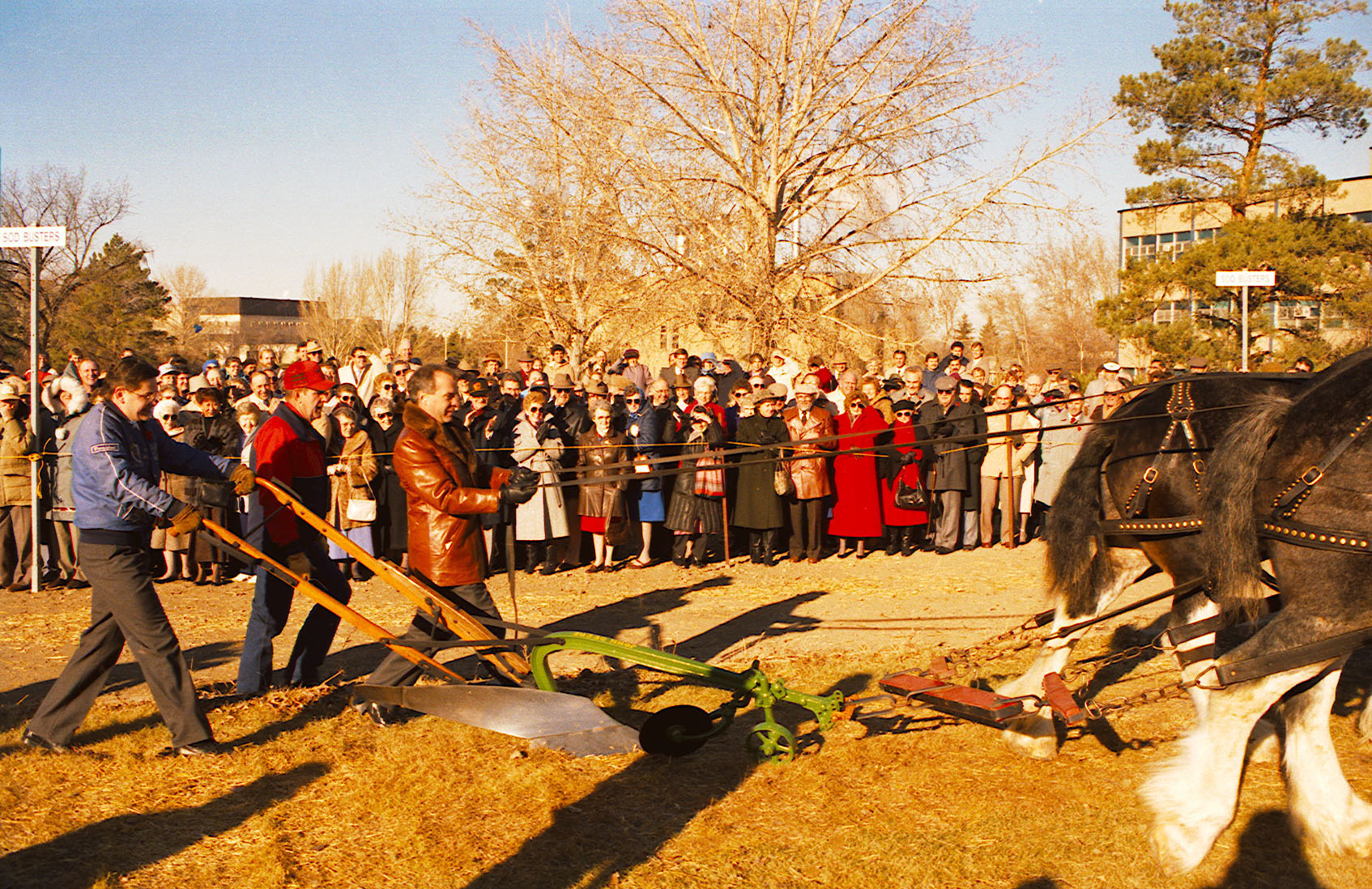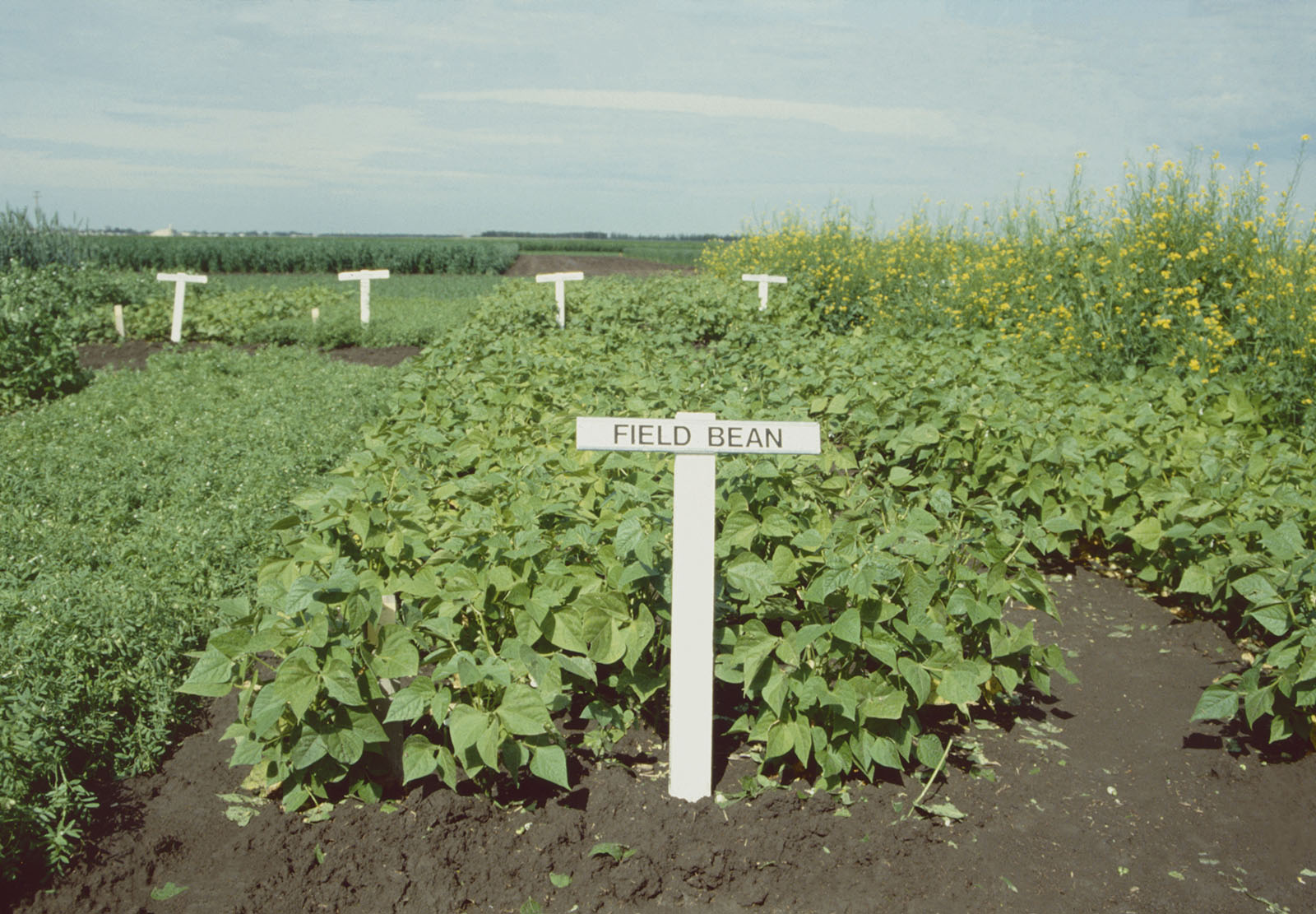
1990s
The beginning of funding partnerships.
By Kathy Fitzpatrick
As the University of Saskatchewan’s (USask) Crop Development Centre (CDC) entered its third decade, challenging economic times gripped the country and the province. A recession and crippling government debt prompted widespread budget cuts at both the provincial and federal levels.
The impacts rippled down to the CDC, forcing it to adapt its own operations during the 1990s. Two projects, weed control and sustainable cropping systems, ended early in the decade. As well, two scientists and several support staff lost their jobs due to funding cuts. Meanwhile, research, extension and funding partnerships with the private sector and non-governmental organizations continued to grow and develop, becoming all the more vital to the CDC’s success. Through it all, the CDC continued to make important research advances, aided by access to expanded infrastructure.
Flax breeder Dr. Gordon Rowland (PhD), who became director of the CDC in 1994, says the credibility the CDC established for itself in its first two decades of operation helped shield it from more drastic impacts of the economic downturn.
“A concentration of plant breeding expertise and facilities and land in one place in the province” combined to make the CDC “the greatest plant breeding and crop development organization ever established in Canada,” Rowland says.
The CDC’s close and co-operative working relationship with provincial government officials saved it from a severe cut that had been proposed for the 1992-93 fiscal year, roughly in the order of one-quarter to one-third of the CDC’s total budget, Rowland recalls.
In discussions with the incoming administration following the 1991 general election, Rowland was assured the budget cut would not proceed. “We had all the facts and figures to present to them. And so they understood,” he says.
Rowland was the CDC’s first dedicated director. Before then, the post was part of the duties carried out by the head of crop science. However, Rowland says the growth of both the CDC and the crop industry in Saskatchewan made the split into two positions necessary. His heavy schedule of meetings was such that “I don’t think I sat down for those five years that I was director,” he explains.
The impact of the CDC’s work was again demonstrated by the surprise success of CDC Teal, an early-maturing and rust resistant hard red spring wheat developed by Dr. Geoff Hughes (PhD) and Dr. Pierre Hucl (PhD), and released in 1991. Teal was better suited to the moister conditions of eastern Saskatchewan and Manitoba, and also offered better lodging resistance than older varieties Hucl says, but “we really didn’t know what its success would be like.”
However, Teal shot to stardom after the UK bakery Warburtons chose the variety as a key ingredient in its flour blend, due to its superior dough strength. As in many of the CDC’s flagship varieties, luck and timing played their parts. Hucl says Teal was not intentionally developed for its greater dough strength. Meanwhile, the variety performed well in the field during the wet years that followed the eruption of Mount Pinatubo in 1991. By the late 1990s, Teal made up about one-fifth of wheat acres in Western Canada.
Teal’s success helped give the CDC credibility to continue receiving funding for wheat breeding, Hucl notes, such as through volunteer producer checkoffs. Although revenue from checkoffs covered about a quarter of the wheat breeding program cost, it leveraged grants from other sources as well. “Once that funding flowed, then other funders went ‘oh, okay these folks have critical mass, they can achieve things,’” Hucl says.
Top personnel at the CDC had played pivotal roles in establishing producer checkoffs, or per-unit financial contributions. In the case of wheat and barley, checkoffs were deducted from sales through the Canadian Wheat Board, with funds administered and distributed by the Western Grains Research Foundation (WGRF). Dr. Herman Austenson (PhD) (who joined the crop science department in 1966 and was department head and CDC director from 1975 to 1982) had sought the support of both farmers and governments for such a system to finance research funding. His colleague Dr. Doug Knott (PhD) (head of crop science from 1965 to 1975) had also promoted the idea of a province-wide producer checkoff. Austenson would go on to become executive director of the WGRF from 1989 to 1996.

As Rowland wrote in his 1995-96 CDC annual report, the check-off was “an enormous boost to our cereal breeding efforts” in malting barley, feed barley, hulless barley, hard red spring wheat, Canadian Prairie Spring wheat, winter wheat and durum wheat.
Meanwhile, during the mid-1970’s pulse breeder Dr. Al Slinkard (PhD) and John Buchanan, Special Crops Agronomist with Saskatchewan Agriculture, had encouraged growers to form their own association.
In 1997 producer checkoffs funded an important agreement between the Saskatchewan Pulse Growers (SPG) and the CDC. In exchange for an annual grant of $340,000 from the SPG, the CDC assigned the marketing rights of all new CDC pea, lentil, dry bean and chickpea varieties to the SPG. Meanwhile, the SPG purchased two quarter sections of land near Saskatoon for pulse crop research, renting it to the CDC for $1 per year.
Prior to that, the CDC had also secured a $2.6 million endowment from the Canada-Saskatchewan Agri-Food Innovation Fund to hire a chickpea and dry bean breeder. In May of 2000, a pulse crop pathologist was
also added to the roster.
As well, the Saskatchewan Wheat Pool (SWP) entered into an agreement turning over breeding and testing of its hard red spring and durum wheat projects to the CDC. The SWP would provide funds to help finish off their material for release as varieties. Ownership of all the genetic material would revert to the CDC in 1998, while the SWP would retain first right of refusal to commercialize any of the varieties arising from its genetic material. Hucl, who describes this as an early private-public partnership, says “in a way (it) was ground breaking without us really realizing the significance of it.”
In landing agreements such as these, the CDC built on its history of partnerships with agencies and industry. An example is Quaker Oats’ long-running support of the oat breeding program.
Also, a close working relationship between crop breeder Dr. Brian Fowler (PhD) and Ducks Unlimited that began in 1992 helped sustain producer interest in winter wheat. The crop’s value to waterfowl conservation is this: Because winter wheat is planted in the fall then grows quickly the following spring, it provides secure habitat for nesting. (Dabbling ducks hatch their young away from wetlands, then lead them back to water.)
As for facilities, the CDC’s move into the new College of Agriculture building in 1991 was a significant morale boost. Before then, CDC scientists worked in the University’s Crop Science Building (which was to subsequently house archaeology and anthropology). Hucl recalls working from a “turret” in the old building with a “medieval slit window”. “I was stuck in this little cubby hole and then went into this beautiful brand new building with great facilities,” including the Controlled Environment Facility (or, Phytotron, as it’s also known), the largest and most state of the art in the country at the time, Hucl says. The CEF contains 183 environmentally controlled reach-in cabinets and walk-in rooms, which can be set to replicate growing conditions such as qualities and intensities of light, temperature ranges and humidity.

The new Agriculture Building also featured brand new labs, furnished with the aid of substantial donations. The college’s new greenhouses, which opened in 1994, provided more space and improved growing conditions. CDC scientists also worked to develop and expand disease nurseries. Pathology (the science of causes and effects of diseases) is critical to plant breeding, Hucl explains.
Towards the end of the decade, the Field Laboratory at Preston and 108th was expanded with two new rooms, one for the winter wheat program and the other for the durum program. Meanwhile, the former winter wheat trailers were dismantled to make way for a new seed storage building. It was to hold all of the seed that was to that point stored in the Field Laboratory, which had become overrun with mice.
The seed storage building’s rodent-proof design was crucial in protecting staff from hantavirus. Spread by infected rodents, deer mice in particular, it can cause a deadly lung disease.
Although no deer mice specifically were found in the Field Lab, the presence of other mouse species “was really an impetus for us to say, okay, we need to have our seed in a facility with no running water, that’s contained and we can control the mice,” Hucl says.
As well, in May of 2000 a new Breeder Seed Cleaning Building at the Kernen Crop Research Farm was completed. The cost of around three-quarters of a million dollars was covered with funds from the Kernen Trust and royalties from the sale of CDC varieties. A $225,000 grant from the Saskatchewan Pulse Growers, matched by the Canada-Saskatchewan Agri-Food Innovation Fund, enabled the CDC to acquire the most advanced seed cleaning equipment.
Meanwhile, through the 1990s the CDC continued releasing new crop varieties. In addition to Teal, other notables include: CDC Kestrel (the first winter wheat developed at the centre); CDC Redwing (the centre’s first red lentil); CDC Maria (the first hairless variety of canary seed, bred to prevent skin irritation suffered by farmers at harvest); CDC Mozart yellow pea; and CDC Bethune flax (known for its stable yields).
